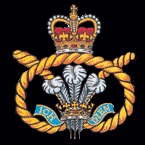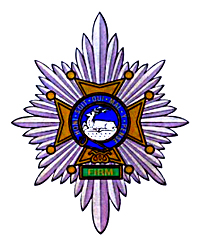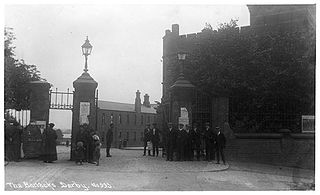
The Staffordshire Regiment (Prince of Wales') (or simply "Staffords" for short) was an infantry regiment of the British Army, part of the Prince of Wales' Division. The regiment was formed in 1959 by the amalgamation of the South Staffordshire Regiment and the North Staffordshire Regiment (Prince of Wales'), and in 2007 was amalgamated with the Cheshire Regiment and the Worcestershire and Sherwood Foresters Regiment to become the 3rd Battalion, Mercian Regiment.
Options for Change was a restructuring of the British Armed Forces in summer 1990 after the end of the Cold War.

The Mercian Regiment is an infantry regiment of the British Army, which is recruited from five of the counties that formed the ancient kingdom of Mercia. Known as 'The Heart of England's Infantry', it was formed on 1 September 2007 by the amalgamation of three existing regiments. The Regiment has had fifteen operational deployments since its formation.

The Worcestershire and Sherwood Foresters Regiment was an infantry regiment of the British Army, part of the Prince of Wales' Division. The regiment served as the county regiment for Derbyshire, Nottinghamshire and Worcestershire.

The 29th (Worcestershire) Regiment of Foot was an infantry regiment of the British Army, raised in 1694. Under the Childers Reforms it amalgamated with the 36th (Herefordshire) Regiment of Foot to become the 1st Battalion, the Worcestershire Regiment in 1881.

The Grey and Simcoe Foresters is a Primary Reserve infantry regiment of the Canadian Forces. Within the Canadian Army, it is part of the 4th Canadian Division's 31 Canadian Brigade Group. Due to the restructuring of the British Army, The Worcestershire and Sherwood Foresters Regiment was amalgamated into The Mercian Regiment, as its 2nd Battalion, leaving The Grey and Simcoe Foresters as the only remaining unit in the Commonwealth of Nations known to be distinctly designated as a regiment of Foresters.
The Prince of Wales's Division was a British Army command, training and administrative apparatus designated for all land force units in the West of England and Wales. It merged with the Scottish Division, to form the Scottish, Welsh and Irish Division; at the same time the Mercian Regiment joined with the King's Division.

The Queen's Division is a British Army training and administrative apparatus for infantry regiments from the East & South of England, and Gibraltar.

Susannah Jane Lamplugh was a British estate agent reported missing on 28 July 1986 in Fulham, London, England, United Kingdom. She was officially declared dead, presumed murdered, in 1993. The last clue to Lamplugh's whereabouts was an appointment to show a house in Shorrolds Road to someone she called Mr. Kipper. The case remains unsolved.

104 Regiment Royal Artillery is part of the British Army Reserve and has sub-units throughout Wales and the West Midlands of England. It is equipped with the 105mm Light Gun.
The West Midlands Regiment was a short-lived British Territorial Army regiment from 1999 until it was re-designated as 4th Battalion, Mercian Regiment, in 2007.

The Sherwood Foresters was a line infantry regiment of the British Army in existence for just under 90 years, from 1881 to 1970. In 1970, the regiment was amalgamated with the Worcestershire Regiment to form the Worcestershire and Sherwood Foresters Regiment, which in 2007 was amalgamated with the Cheshire Regiment and the Staffordshire Regiment to form the present Mercian Regiment. The lineage of the Sherwood Foresters is now continued by The Mercian Regiment.

The 36th (Herefordshire) Regiment of Foot was an infantry regiment of the British Army, raised in 1701. Under the Childers Reforms it amalgamated with the 29th (Worcestershire) Regiment of Foot to form the Worcestershire Regiment in 1881. Its lineage is continued today by the Mercian Regiment.

The Worcestershire Regiment was a line infantry regiment in the British Army, formed in 1881 under the Childers Reforms by the amalgamation of the 29th (Worcestershire) Regiment of Foot and the 36th (Herefordshire) Regiment of Foot. The regiment fought in many conflicts, including both the First and Second World Wars, until 1970, when it was amalgamated with the Sherwood Foresters to form the Worcestershire and Sherwood Foresters Regiment. In September 2007, the regiment amalgamated with the Cheshire Regiment and the Staffordshire Regiment to form the Mercian Regiment.
The Mercian Brigade was an administrative formation of the British Army from 1948 to 1964. The Brigade administered the infantry regiments from the area of England between the Trent, Mersey and Severn rivers that roughly corresponded to the ancient kingdom of Mercia.
In countries whose armies are organised on a regimental basis, such as the army of the United Kingdom, a regimental museum is a military museum dedicated to the history of a specific army regiment.

The regimental depot of a regiment is its home base for recruiting and training. It is also where soldiers and officers awaiting discharge or postings are based and where injured soldiers return to full fitness after discharge from hospital before returning to full duty. Normally, a variety of regimental stores will also be kept at the depot. The regimental depot is not the same as the regimental headquarters, though in practice the two will often be co-located in the same place.
John David Guise Cannan is a British murderer, serial rapist, serial abductor and suspected serial killer. A former car salesman, Cannan has claimed to have had 100 one-night stands and was said to be charming.

Normanton Barracks was a military installation in Normanton, Derby, England.

Queen's Barracks was a military installation in Perth, Scotland.
















